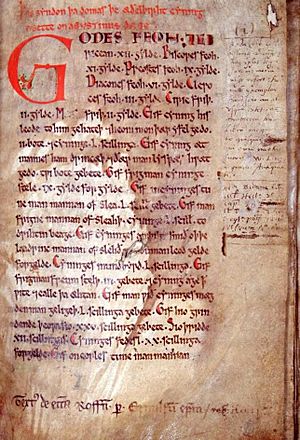Textus Roffensis facts for kids
The Textus Roffensis is a very old book, also known as "The Tome of Rochester". It's a manuscript, which means it was written by hand a long, long time ago. This special book was created between the years 1122 and 1124.
It's actually made up of two different parts joined together. You can find it today at Rochester Cathedral in Rochester, Kent, where it's on display. Experts believe one person wrote most of the book. However, another person added some notes in English to the Latin parts. These notes might have been used during old court cases.
What's Inside the Book?
The Textus Roffensis has two main sections. The first part is a collection of old laws and other important documents. Many of these laws come from Anglo-Saxon times. This section is super important for anyone studying early English law.
It starts with the very first royal law-code we know of! This code was made by King Æthelberht of Kent around the year 600. After that, it includes laws from other Kentish kings like Hlothere, Eadric, and Wihtred. This book is the only place where we can read these specific laws today.
The second part of the book is called a cartulary. This is a collection of important documents, like property records, for the Rochester Cathedral priory. It's written in Latin, but the very last part is in English.
Here are some of the interesting things you can find in the first part of the book:
| Item | Dates | What it's about | Language |
|---|---|---|---|
| 1 | Around 600 | King Æthelberht's Laws (the oldest English law code!) | English |
| 2 | 679-695 | Laws from Kings Hlothere and Eadric | English |
| 3 | 695 | King Wihtred's Laws | English |
| 6 | After 893 | Laws of King Alfred, including older laws from King Ine | English |
| 9 | 924–939 | Æthelstan's Grately Law Code | English |
| 17 | 942–946 | King Edmund's Church Laws | English |
| 20 | 1066–1087 | Laws from William I (about lawsuits between English and French people) | English |
| 24 | 1016–1035 | Laws from King Cnut | Latin |
| 28 | ? | Geðyncðo (about social status) | English |
| 31 | ? | A charm to prevent cattle theft! | English |
| 33 | 1100 | King Henry I's Coronation Charter | Latin |
Why is it Called Textus?
In the Middle Ages, a textus was a special book. It usually had a fancy, decorated cover. These books were important enough to be kept near the main altar in a church. A liber was a simpler book, kept in the cloister (a covered walkway).
It was rare for a book about everyday laws to be called a textus. So, the name Textus Roffensis shows how important this book was considered during the Middle Ages.
The Amazing Scribe Who Wrote It
The person who wrote the Textus Roffensis is unknown, but they were very skilled! They knew a lot about old forms of English. They could copy accurately from many original Anglo-Saxon documents. Some of these documents were written in the local Kentish language.
This was quite unusual because it was written a few generations after the Norman Conquest in 1066. By then, many people didn't understand the old English dialects anymore. To copy King Æthelberht's Laws, the scribe was reading a language that was about 500 years old!
The scribe used different writing styles for English and Latin. For English, they used a style called Insular Minuscule. For Latin, they used Caroline Minuscule. This was a common practice around the year 1000. However, by the time the Textus Roffensis was made, the Insular Minuscule style was becoming less common.
The scribe made very few mistakes. They only made small changes to update some words. For example, in the Laws of Ine, the scribe changed an old word for "baptised" to a newer one. They also changed a word for "wealth" to "slave." This might show how ideas about slaves were changing after the Norman Conquest.
Overall, the Textus Roffensis scribe was very careful and respectful of the old texts they were copying.
History of the Book
The two parts of the Textus Roffensis were put together and bound around the year 1300. The first part contains the Law of Æthelberht, which is the oldest surviving English law code. It's also the oldest Anglo-Saxon text we still have! The second part is the oldest record book for Rochester Cathedral. The whole book has 235 pages made of vellum (animal skin).
Over the centuries, the Textus Roffensis has had quite an adventure! It has been loaned out, lost, and found again many times. At one point, it was even dropped in a river! Sometime between 1708 and 1718, the ship carrying the book overturned. It spent several hours in either the River Thames or the River Medway. You can still see water damage on some of its pages today.
The British Library once called this book "Britain's Hidden Treasure." Today, you can see it displayed safely in an airtight case in the crypt of Rochester Cathedral. It has also been scanned and put online by The University of Manchester. You can view the full digital copy on the Rochester Cathedral website. A short film about the book's history and how it was digitized has also been made.


